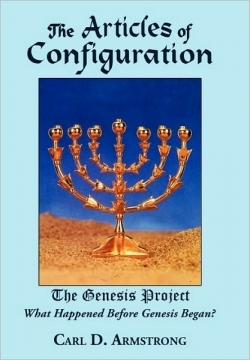The Articles of Configuration: The Genesis Project
In the ongoing debate between religion and science, author Carl D. Armstrong tackles the enormous subject of what exactly might have occurred before both the Genesis creation story and the Big Bang theory. He also proposes other comparisons between religion and science. In a series of eleven chapters, which can be read independently or as a whole, the author maintains that he can reconcile science and religion, and that in the Bible he can locate evidence of certain scientific theories, such as the string theory and the membrane theory. In order to assist readers, the final chapter provides useful, short summaries of the preceding ten chapters.
The author raises many thought-provoking points, such as how the Bible mentions the relationship between the sun’s rays and the earth’s magnetic shield as protection from radiation. For this discussion the author reads Psalm 84:11 literally as an example: “For the LORD God is a sun and shield: the LORD will give grace and glory: no good thing will he withhold from them that walk uprightly. O LORD of hosts, blessed is the man that trusteth in thee.” He further posits that the Hebrew menorah serves as an ancient symbol representing the scientific string theory and membrane theory. He also maintains that Hebrew prophets provided a detailed description of the human brain. For example, he compares the thirty-one nerves in the spinal cord to the thirty-one subdued kings in the Promised Land, as well as to the thirty-one rooms in Solomon’s temple. He similarly compares two cherubim to the brain’s two hemispheres and relates the pineal gland to the Ark.
Certain mechanical adjustments might help the author present his theories more strongly. Citations and references, for example, should reflect publishing information more detailed than ISBN numbers, and some information needs to be cited completely, such as the court case which describes the notion of a chain of custody. Stylistically, some readers might find the author’s use of many questions and casual language off-putting. Finally, others might bristle at the author’s use of “flashback” biblical citations.
An engineering graduate of the University of Missouri School of Mines and Metallurgy, the author has a strong interest in both scientific and spiritual studies, and is now retired. Armstrong has traveled to Haiti, Africa and Israel and has identified interesting material to study. Some tidying up of writing style and consistency of citation should help to clarify his topic, which will appeal to readers interested in the merging of religion and science.
Reviewed by
Beth Hemke Shapiro
Disclosure: This article is not an endorsement, but a review. The publisher of this book provided free copies of the book and paid a small fee to have their book reviewed by a professional reviewer. Foreword Reviews and Clarion Reviews make no guarantee that the publisher will receive a positive review. Foreword Magazine, Inc. is disclosing this in accordance with the Federal Trade Commission’s 16 CFR, Part 255.

